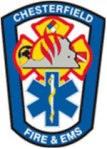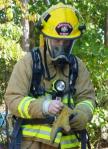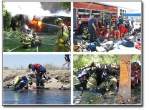By: Robert Avsec
Professional Disclaimer: I do not profess to be a subject matter expert in the area of volunteer fire department operations.
There, now that we have that out of the way, allow me to say that  I’m not entirely “unschooled” when it comes to working and learning with volunteer firefighters. I served for 26 years with the Chesterfield County (VA) Fire and EMS (CFEMS) Department from 1982 to 2007. CFEMS is a combination department and during my career I was part of an organization that evolved from being a county fire department staffed by volunteers and supplemented by career personnel to one that was staffed by career personnel and supplemented by volunteers.
I’m not entirely “unschooled” when it comes to working and learning with volunteer firefighters. I served for 26 years with the Chesterfield County (VA) Fire and EMS (CFEMS) Department from 1982 to 2007. CFEMS is a combination department and during my career I was part of an organization that evolved from being a county fire department staffed by volunteers and supplemented by career personnel to one that was staffed by career personnel and supplemented by volunteers.
During that successful transformation problems got easier to identify and solutions easier to find when we–career and volunteer members–worked together using some basic quality improvement tools. (Based on what I’ve seen and heard about similar transformations in other departments over the years, I feel confident saying we were successful). Some of those basic quality tools included:
- Focus groups;
- Cause and Effect Diagrams, aka, “Fishbone” Diagrams;
- Failure Tree Diagrams;
- Process Flowcharts; and
- Nominal Group Technique Voting.
If you’re not familiar with these tools I highly recommend a FREE on-line program from the National Quality Center entitled, NQC Quality Academy: Useful Quality Improvement Tools. The program is 29+ minutes in length and provides a wonderful introduction to these tools and several others.
See Related: 5 critical issues facing volunteer firefighters
One of “big ticket” volunteer issues that we tackled using these tools was the declining number of volunteer firefighters in the department. We assembled a Process Action Team (PAT) composed of nine firefighters and officers from both the career and volunteer ranks:
- Two career battalion chiefs;
- A career lieutenant;
- A career firefighter;
- Two volunteer district chiefs;
- A volunteer captain; and
- Two volunteer firefighters.
Along with a written description of its mission, the PAT was given a “time” budget of 60 days to complete its work and give its recommendations to the Fire Chief for his review and approval.
I’ll not go into great detail in this piece, and instead will get right to the “good stuff”. One of the “Aha Moments” was when our work uncovered an underlying issue that affected volunteer recruitment and retention: volunteers didn’t get to participate in service delivery.
IRS Publishes Final Obamacare Regs Clarifying Volunteers not Subject to Employer Mandate
From the volunteer fire company perspective, they were getting people in and getting those folks the required training, but then they were not able to actively participate in service delivery. There was a broad-based feeling (revealed when we conducted focus groups with volunteers) that all they ever got to do was “be the backups”.
In CFEMS, at the time of this PAT’s work, the fire stations staffing looked like this:
In those nine stations with combination staffing, the career firefighters staffed the first out Type I engine while the volunteers staffed the second-out Type I engine. (In addition to their Type I engine, depending upon the station’s assigned apparatus, the volunteers also staffed a Type III engine, Tender, or Rescue/Utility truck).
A typical single-family dwelling structure fire assignment received three engine companies, a truck company, and an ambulance. When those three engine companies came from combination stations the following staffed apparatus (units) could show up:
- Three first-out Type I engines (staffed with career personnel);
- A truck company (staffed with career personnel);
- Three second-out Type I engines (staffed by volunteer personnel); and
- Any of the other types of apparatus from those three engine company stations that the volunteers could staff and respond.
Needless to say, such a staffing scheme did not provide many opportunities for volunteer staffed units to actively engage in the active firefighting tasks of first-arriving units. Those volunteer firefighters that did respond were typically assign to overhaul and salvage tasks or support activities such as repacking hose or assisting fire investigators during their work.
It’s American Heart Month! Are You Heart Strong?
 “Digging” deeper into the problem, the PAT learned that volunteer firefighters rarely had the opportunity to participate even when a response called for a single engine company (Remember, a single combination engine company consists of two Type I engines, a Type III engine, etc.).
“Digging” deeper into the problem, the PAT learned that volunteer firefighters rarely had the opportunity to participate even when a response called for a single engine company (Remember, a single combination engine company consists of two Type I engines, a Type III engine, etc.).
In the majority of cases, by the time volunteers could respond to their combination station and staff their Type I engine and respond, the first-in Type I engine (staffed by career personnel) had already arrived, taken action, and marked the situation “under control”.
So what was the PAT’s recommendation? Volunteer Duty Crews (VDC). The PAT took historical response data from the County’s Computer Aided Dispatch System (CADS) for the nine combination staffed engine companies and “plugged” that data into histograms, another quality improvement tool. In doing so, the team was able to categorize each engine company’s call activity by time of day and day of the week.

An example of a histogram completed for one Fire Station for calls by day of week for hours 2000-0600 hours.
The PAT then “sketched out” staffing schedules for each of those stations when it would be most productive to have volunteers “on duty” in their stations, ready to respond to calls as opposed to responding from home.
The PAT’s recommendation also included another parameter: don’t try to staff every station, every night with VDCs. The concept was to increase the ability for volunteers to actively participate, not add additional “stress” on their membership rolls. (The members of the PAT felt strongly that if successful, the volunteer element in the department would see some growth as volunteer members were more active in the delivery of services).
For example, the VDC schedule for Engine Company 3, located along the busy U.S. Route 1 and I-95 corridor through the county, called for VDC staffing on Thursday, Friday, Saturday and Sunday nights, the four busiest nights of the week from a historical data standpoint.
Personnel staffing a VDC (consisting of a qualified officer, driver/operator, and firefighter) would be on duty in their station from 2000 hours to 0600 hours the following morning. Each VDC, when possible, would be composed of a different set of personnel for each tour of duty.
A VDC w ould respond their Type I engine as the first-out piece to any engine company response for their first due district for which they were qualified. (If a VDC, for example, was not Advanced Life Support (ALS) staffed and the response called for an ALS-staffed unit then the career-staffed unit would take the call).
ould respond their Type I engine as the first-out piece to any engine company response for their first due district for which they were qualified. (If a VDC, for example, was not Advanced Life Support (ALS) staffed and the response called for an ALS-staffed unit then the career-staffed unit would take the call).
Positive Outcomes for Volunteer Personnel
The VDC concept, in those stations that successfully implemented it, provided several positives for the volunteer personnel including, but not limited to:
- Personnel had more opportunities for meaningful participation in the service delivery for which they had trained.
- More effective and efficient use of volunteer personnel time. For those single engine company responses, there was no expectation of additional volunteer responding to the alarm. Since the alarm would be handled by the VDC-staffed unit, and backed up by the career-staffed unit if necessary, those volunteer personnel not on duty were not “burning themselves out” responding to single engine company alarms where they were not needed.
- The workload on the volunteers was “evened out”. Instead of a typically small core group of volunteers carrying the bulk of responses for their station, more volunteers had the opportunity to participate. Their proximity to the fire station, their work schedules, and their family commitments had less of an influence on their ability to meaningfully participate.
- The “stock” of volunteers rose with career personnel as the volunteers had more opportunities to demonstrate their ability to get the job done safely, effectively, and efficiently. This helped to foster a higher level of respect and cooperation between the volunteer and career staffs.
So check out some of those quality tools and see if they can help you and your department to find solutions to some of the issues affecting volunteers in your department.
Check out the programs available at the National Volunteer  Fire Council’s website
Fire Council’s website
 Fire & EMS Leader Pro The job of old firefighters is to teach young firefighters how to become old firefighters!
Fire & EMS Leader Pro The job of old firefighters is to teach young firefighters how to become old firefighters!
